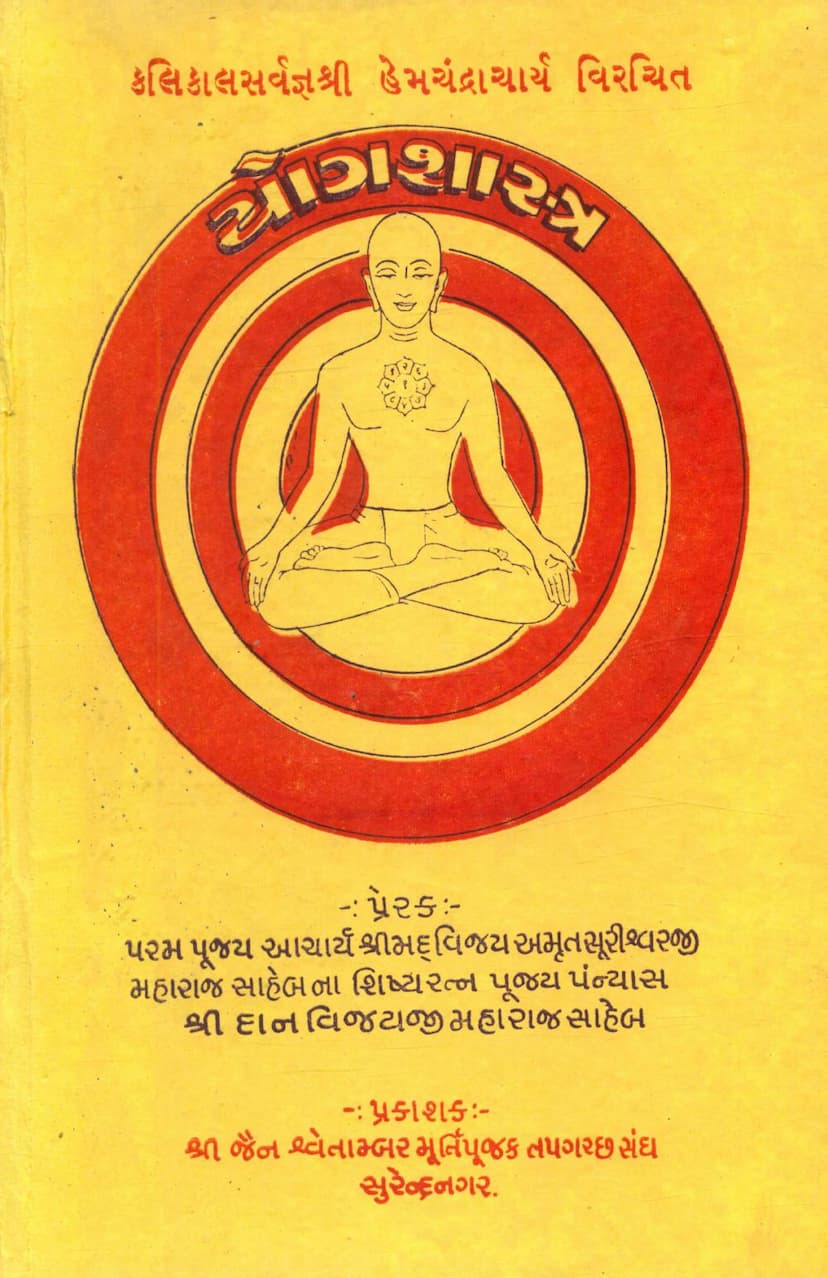Yogshastra
Added to library: September 2, 2025

Summary
Yogashastra by Acharya Hemachandra: A Comprehensive Summary
The provided text is a Gujarati translation and commentary on Acharya Hemachandra's renowned work, the Yogashastra. This summary is based on the comprehensive overview and table of contents presented in the text, which details the twelve sections (Prakash) of the Yogashastra.
Overall Purpose and Context:
The Yogashastra is a foundational Jain text that expounds upon the principles and practices of Yoga as a path to spiritual liberation (Moksha). The translated version, presented here with commentary by Pujya Panvnas Shri Dan Vijayji Maharaj Saheb and inspired by Acharya Shrimad Vijay Amrut Surishwarji Maharaj Saheb, aims to make these profound teachings accessible. The text emphasizes the integration of knowledge (Gyan) and action (Kriya), the importance of unwavering faith (Shraddha), and the holistic development of mind, speech, and body through Yoga.
Key Themes and Structure:
The Yogashastra is structured into twelve distinct sections, each delving into specific aspects of Yoga and Jain philosophy:
I. Introduction and Foundation (Prakash 1-4):
- Mahavir's Teachings: The text begins by highlighting Lord Mahavir's teachings on universal love, compassion, and equanimity, emphasizing their role in spiritual upliftment.
- Importance of Upayoga (Consciousness/Intent): It stresses that the effectiveness of any religious or spiritual practice lies in the user's conscious intent and involvement ("Upayoga is Dharma").
- Gyan Yoga & Kriya Yoga: The book explains that true liberation comes from the synthesis of knowledge and action. Mere knowledge or action alone is insufficient; it must be knowledge-informed action, infused with the conscious use of mind, speech, and body.
- The Power of Faith: Citing Anandghanji's verses, the text underscores that actions without faith are fruitless, like painting on a wall of ash.
- Structure of Yogashastra: The text outlines the twelve sections of Acharya Hemachandra's Yogashastra, detailing the content of each.
II. Principles of Conduct and Asceticism (Prakash 5-11):
- Yama and Niyama (Ethical Observances): The foundational ethical principles for both laypeople and ascetics are explained.
- Yama (Five Great Vows): Ahimsa (non-violence), Satya (truthfulness), Asteya (non-stealing), Brahmacharya (celibacy/chastity), and Aparigraha (non-possession/non-attachment) are detailed, along with their respective five sub-vows (Anuvratas) and their importance.
- Niyama (Observances): While not explicitly detailed in the table of contents, these would likely complement the Yamas.
- Conduct for Householders (Prakash 2): This section focuses on the ethical conduct and virtues required for a householder's life, including Samyakdarshan (right faith), its characteristics, and its corruptions (Mithyatva). It also details the five cardinal vows (Anuvratas) and their practical application.
- Renunciation and Detachment (Prakash 3): This section discusses the importance of detachment from worldly pleasures and the renunciation of prohibited items like alcohol, meat, and certain food items, emphasizing the ethical implications of consumption.
- Control of Passions and Senses (Prakash 4): The text elaborates on overcoming anger, pride, deceit, and greed (Kashayas) and the conquest of the senses (Indriyas) as crucial for spiritual progress.
- Pranayama and Yoga Practices (Prakash 5): This section delves into the technical aspects of Yoga, including Pranayama (breath control), its benefits, and various techniques for regulating breath. It also touches upon the relationship between breath and mind.
- Dharana, Dhyana, Samadhi (Prakash 6-9): The text progresses to the higher stages of Yoga: Dharana (concentration), Dhyana (meditation), and Samadhi (absorption). It explains different types of meditation, including Pindastha (meditation on the body), Padmastha (meditation on seated postures), Rupa-sthita (meditation on forms), and Rupatita (meditation beyond form).
- Types of Meditation: Specific types of meditation are discussed, including mantra meditation, meditation on the Pancaparameshthi (five supreme souls), and various forms of contemplation.
- Spiritual Attainment: The text highlights the spiritual powers (Siddhis) and knowledge that can be attained through Yoga, citing examples of great souls who achieved liberation through these practices.
III. The Path to Liberation (Prakash 10-12):
- The Nature of Reality: The importance of understanding the true nature of the soul (Atman) and its distinction from the non-soul (Jiva and Ajiva) is emphasized.
- Karma and Liberation: The text explains the concept of Karma, its bondage, and the path to its eradication for liberation. It outlines the roles of auspicious (Punya) and inauspicious (Papa) actions and their consequences.
- Samyak Yoga: The ultimate goal is presented as Samyak Yoga, the complete union of soul and supreme consciousness, achieved through the meticulous practice of Yoga.
- The Role of the Guru: The significance of a qualified Guru in guiding the aspirant on the path of Yoga is highlighted.
- The Four Types of Meditation: The text details four stages of meditation: Pindastha, Padmastha, Rupastha, and Rupatita, describing their practices and objectives.
- Achieving the Highest State: The culmination of Yoga is presented as the attainment of the highest spiritual state, free from all karmic bondage and characterized by infinite bliss and knowledge.
Key Figures and Narratives:
The text frequently references and draws parables from Jain tradition, including:
- Lord Mahavir: As the ultimate inspirer and proponent of the spiritual path.
- Acharya Hemachandra: The celebrated author whose principles and wisdom guide the Yogashastra.
- Various Saints and Ascetics: The text includes narratives of individuals who attained spiritual heights through Yoga, illustrating the principles discussed.
- Stories from Jain Lore: The explanations are often enriched with stories of exemplary figures, highlighting the practical application and results of following the Yoga path.
Conclusion:
The Yogashastra, as presented in this translation and commentary, is a comprehensive guide to the practice of Yoga within the Jain framework. It emphasizes a disciplined, ethical, and introspective approach to spiritual development, leading ultimately to the liberation of the soul. The text serves as a profound resource for anyone seeking to understand and practice Yoga for spiritual well-being and ultimate salvation.